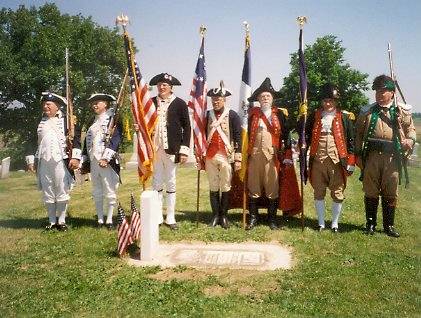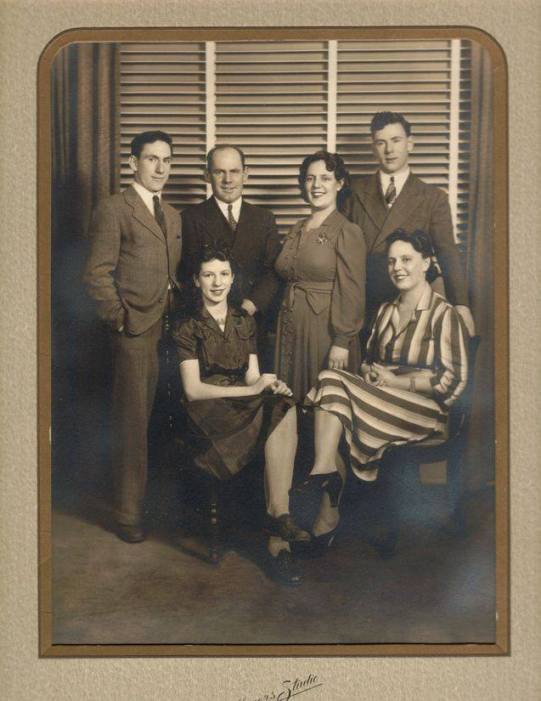
The Story of Joseph Alexander, An American Patriot
Joseph Alexander was born in Northern Ireland, in the
province of Ulster and the County of Tyrone, in the year of 1756. No
further information has been revealed as to his exact date of birth or
the names of his parents. It is known he, his father, and a brother
(whose names are not known) migrated to the shores of America when he
was just a nine-year-old boy. They arrived in Pennsylvania in the year
1765, a fact generally agreed upon by all family histories though this
researcher has located no documentation of their immigration.
In 1765, Pennsylvania was largely wilderness, populated
by warring tribes of Indians. The area was part of the generous charter
made by King Charles II in 1680 to William Penn, the Quaker, as
repayment of a large outstanding loan to the King by Penn’s father, the
Admiral Sir William Penn. Penn wished to name the territory “Sylvania”
meaning “forest land” but King Charles II wished to honor William Penn’s
father and insisted the land be called Pennsylvania. In 1682, Penn
sailed on the Welcome to America, and established the first “planned and
surveyed” city in North America, Phil-Adelphia (the “city of brotherly
love”) a name that soon became commonly written as Philadelphia.
The area, though granted Penn through the King’s
charter, was tribal land, owned and occupied through the ages by several
disparate groups of Indians who disagreed as to their own territorial
boundaries. Penn found it necessary to learn a number of the native
dialects in order to negotiate with the leaders of these tribes
personally for use and extension of his original charter of land. His
primary dealings were with the Leni-Lenape (Delawares), but he sought to
treat all these native tribes fairly. Though his intentions and actions
were honorable in this regard, many who followed to occupy the lands
did not. The question of ownership of the lands settled by Penn’s
colonists remained a strong factor in the later actions of the tribes
during the French and Indian War and, later, the alliances made with the
English or the French during the Revolutionary War.
William Penn, the Quaker, never actually lived in
America, for after the founding of Philadelphia and his travels to
secure additional “treaties” with various Indian tribes, he returned to
England. He desired to raise additional funds to further his colony’s
welfare. He would not return to America until 1699. It is said he (as a
victim of religious persecution himself) was a strong proponent of
religious freedom and, on this trip, sought to establish a federation of
the colonies. Although he owned slaves, it is said he urged the fair
treatment of slaves, in much the same manner he sought to treat the
native tribes fairly in all his dealings. The Quakers, strongly
influenced by Penn’s actions and beliefs, became some of the first to
decry slavery in later years in America.
(Source: Brief History of William Penn, www.ushistory.org)
Given the relative infancy of the settlement of these areas of
Pennsylvania, it is not surprising we have few documents that survived
from that time. Rather, we rely upon the family lore that has survived
and is supported, rarely, by those documents which have been preserved.
We know Joseph Alexander’s personal family documents, such as the family
Bible, fell victim to an Indian attack on his settlement:
“…we learn that his home was burned in 1780 during the warfare
with the Indians on the frontier, destroying the family Bible with
records and his commissions in the Pennsylvania Militia.”
(From History of Montgomery County by Beckwith (1881) page 499.)
From The History of Lycoming County Pennsylvania, edited by John F. Meginness, about 1892, we learn the following:
“Lycoming County originally belonged
to Berks, which was erected March 11, 1752. Twenty years later
Northumberland was formed out of Berks, and twenty-three years after
this, Lycoming came into existence. At that time it covered a region
vast enough in its proportions to constitute a State, and three-fourths
of its territory was practically an unknown wilderness.”
We know that Joseph resided in Northumberland County,
Pennsylvania, for many years following that initial move. His marriage,
his wife’s place of birth, the birth location of most of his children
are all identified with this same area of Pennsylvania. It is known he
married Frances “Fannie” Malone:
“Joseph Alexander married Frances Malone daughter of Richard and Rebecca
Malone, born August 27, 1762. Richard Malone lived in April 1773 six
miles from Fort Augusta (Sunbury) up the West Branch of the Susquehanna
which would be about two miles above the mouth of the Chillisquaque
Creek. His tavern was a prominent place for meetings, notably those of
the County Committee of Safety during the Revolution. Joseph and family
moved to Ross County, Ohio about 1803. In Ohio they lived in Ross and
Clarke Counties until September 1828 when they moved to Montgomery
County, Indiana. "Joseph and his wife came to Montgomery County to live
with their children who had preceded them. They were Joseph, Richard,
Hartley, and Margaret, wife of Joseph Hanks."
(From History of Montgomery County by Beckwith (1881) page 499.)
The four named children are documented by this biographical
sketch. Some researchers, perhaps in the hopes of linking their
heritage to Joseph Alexander’s for membership in the DAR or SAR, have
provided the names of up to eleven children. This researcher has not
been able to document all those children, but firmly believes the eight
named children in our family tree are accurately placed. At the end of
this narrative text, our lineage from Joseph Alexander will be outlined.
The newly formed Congress of the United States on 7 Jun
1832, signed an Act which paved the way for the many Patriots who
served their country during the Revolutionary War to receive the
benefits and monies due but never paid. We, as family historians, are
fortunate that the Pension Application documentation has been preserved
so well through the efforts of our governmental historians. These
documents provide a first-hand account of the majority of the service
and campaigns in which our ancestors participated.
Joseph Alexander filed his Pension Application on 19
March 1833, in Montgomery County, Indiana. Details of his service, and
of his life as well, are revealed through an examination of that Pension
Application. That narrative text (as originally written by hand) of his
Application states:
- That he enlisted in the army of the United States about Christmas in
the year 1777 as a volunteer private under Captain Hugh White in the
Regiment of Pennsylvania militia, at Sunbury in Northumberland County
State of Pennsylvania and marched thence to Philadelphia, Thence to
Trenton and Princeton and Piscatagner and near to Amboy where the
British then was, and was discharged deponent thinks at Springfield
about the 1st of April 1778 and marched to Philadelphia for this pay
- deponent was in ten skirmishes during this tour among which were the
skirmish of the Ash Swamp, Camron's Hills Piscatagner and one at a place
called Crow as Deponent thinks in New Jersey
Durring this tour Deponent was elected an ensign of said company
The Battle of Ash Swamp, A.K.A. The Battle of Short Hills New Jersey
fought 26 Jun 1777 is known as the Crossroads of the American
Revolution (1). The Battle of Ash Swamp was also known as the Battle of
Short Hills. The fight, in the summer of 1777, pitted the British
regulars of Gen. George Cornwallis against Continental soldiers under
the leadership of Lord Stirling. It was not a pivotal battle like
Saratoga or Trenton. However, the fight was significant for two reasons:
Stirling's defense here in Scotch Plains allowed Gen. George
Washington, awaiting the outcome of the battle in nearby Green Brook, an
escape to his encampment at Middlebrook, Franklin Township; and it was
the first battle where Americans fought after the adoption of the
American flag by Congress, thereby defending the Stars and Stripes.
Clark historian Bill Fidurski says you can make a case that the Battle
of the Short Hills was the first clash where Americans defended the
Stars and Stripes.
"The flag resolution was adopted by the Continental Congress at
Philadelphia twelve days earlier," he says, "and there were no
significant engagements anywhere in the colonies between that time and
the battle at the swamp. We don't know if the American troops at Ash
Swamp fought under the Stars and Stripes, but you can say figuratively
at least that they were the first to defend it."
(Source: A Guide to New Jersey's Revolutionary War Trail: For Families and History Buffs, by Mark Di Ionno, p. 167
The Battle of Ash Swamp: Sources:
1) http://aithistory.org/us_history/ash_swamp/
and http://www.revolutionarynj.org/
From Wikipedia, the free encyclopedia:
Battle of Short Hills -- Part of American Revolutionary War
* Date: July 26, 1777
* Location: Short Hills, New Jersey
* Result: Tactical American Victory - Strategic British Victory
* Strength: 2,200 versus 15,000+ (4,000 engaged)
* Casualties and losses: 12 killed, 50 wounded, 50 captured, versus 70 killed and wounded
The Battle of Short Hills (or the Battle of Metuchen Meetinghouse)
was a conflict between a force of Americans commanded by General William
Alexander ("Lord Stirling"), and an opposing British force commanded by
General William Howe, that took place on July 26, 1777, at Short Hills,
in New Jersey, during the American Revolutionary War. William Howe,
leader of the large British force at the Battle of Short Hills; George
Washington, leader of the main army of American troops.
<>Prior to the battle the British tried to lure George
Washington's army into a place where it could be conquered by the larger
British army. However, the smaller American force won the battle.
Prelude: Before the battle, in the early days of June, General William
Howe's British force of almost 17,000 withdrew from Somerset Court House
at New Brunswick, to Perth Amboy, after they failed to draw
Washington's central army from their post at Middlebrook Heights, the
plan having been foiled by the tactics of Lord Stirling. The failure of
the British ploy proved a major setback: success would have forced the
small poorly-equipped American force to fight the larger British army on
the flat plain of New Jersey. Instead of falling for this trap,
Washington followed the retreating British, having left his post in
Middlebrook in the Watchung Mountains, as well as considering the
possibility of assaulting their poorly armed rear guard. Washington
harassed the British as they withdrew into Somerset and Middlesex
counties, while troops under Stirling further irritated the retreating
British.
After withdrawing to Perth Amboy, Howe counterattacked, meaning to
devastate Lord Stirling's forces, cut off Washington's retreat back to
Middlebrook, and engage the Americans in a pitched battle.
The Battle: The ensuing battle between the American forces of
Stirling, which numbered only about 2,200, and the British and Hessian
forces of Howe, proved extremely intense, but with Stirling suffering
only minor losses. However, Stirling was gradually forced backward,
leading both of the armies into the Ash Swamp and Scotch Plains. Severe
cannon fire forced Stirling, as determined as he was to stand against
his foe, to retreat even further back, toward Westfield. However,
Stirling's efforts in the Battle of Short Hills allowed his regiment to
successfully reform with Washington's army and return to the post at
Middlebrook. For these reasons, as well as the large amount of
casualties inflicted on the British, the battle is considered an
American victory. The British then were able to return safely to their
post at Perth Amboy, leaving the American forces to ponder on what
Howe's next action would be.
(Sources:
1. The Battle of Short Hills. Retrieved on 20 April, 2007.
2. The Star ledger. Retrieved on 20 April, 2007. 3. History of the Jersey Brigade. Retrieved on 20 April, 2007.
- Deponent recollects to have been on this tour (?). Putnam and
Mansfield of the regular army, and Col. Cook with his regulars
cooperated at the Battle of Ash Swamp. This tour was three months or
more. Deponent having enlisted at Sunbury in the fall 1778 for a three
month tour (having been ordered out for (?) under Capt James McMahan of
the Pennsylvania Militia being under the commission of Col. Frederick
Antis was first Llietenant said company, and marched to the west branch
of the Susquahanna span the Big Island where they remained guarding the
frontier during the winter and were discharged in the spring of 1779 at
Pine Creek
From the USGenWeb’s archives, generously provided for
free research, we are treated to some valuable documents that reveal the
hardships faced by our brave ancestors as they fought for our country’s
independence. Below is narrative text, as selected extracts, from one
of these, titled Area History: Bell’s History of Northumberland County,
PA – THE REVOLUTIONARY PERIOD, a file contributed for use in USGenWeb
Archives by Tony Rebuck,
“Although the early settlement of Northumberland county occurred
during the period of tranquility following the close of the French and
Indian war, the possibility of future hostilities was a constant
incentive to military organization, while the circumstances of frontier
life were eminently calculated to foster a spirit of independence; and
thus her people, although deficient in the elements of wealth and
comparatively few in numbers, were well prepared for the Revolutionary
struggle. In all the movements preliminary to the organization of the
State government they were represented. The first of these was the
"Meeting of the Provincial Deputies," July 10th, 1774; it was called by a
committee of correspondence at Philadelphia, the chairman of which,
Thomas Willing, addressed a letter to William Maclay, William Plunket,
and Samuel Hunter on the 25th of June, 1774, in compliance with which
the different townships elected committee-men who met at (*) Richard
Malone's on the 11th of July and selected William Scull and Samuel
Hunter to represent the county.
“During the progress of these developments the county was well
represented at the front. A resolution was adopted by Congress, June 14,
1775, directing the formation of ten companies of expert riflemen, six
in Pennsylvania, two in Maryland, and two in Virginia - to be employed
as light infantry and be paid the following sums per month: a captain,
twenty dollars; a lieutenant, thirteen and one third dollars; a
sergeant, eight dollars; a corporal, seven and one third dollars; a
drummer, seven and one third dollars, and a private, six and two thirds
dollars - all ‘to find their own arms and clothes.’
(*) Richard Malone was the father of Francis “Fannie” Malone, wife of
our Patriot, Joseph Alexander. Richard kept a public house which was
the regular meetinghouse for the Patriots, their Commanders, their
funding groups, and the regulars in the Continental Army in that area.
He was this researcher’s 5th Great Grandfather.
These groups of militia were not large. They were comprised
of the best marksmen their county could rally. The following shows the
typical size of each group. (This also extracted from Bell’s History:
The following "Return of the Second battalion of
Northumberland county militia, commanded by Colonel James Murray, May 1,
1778," on file in the office of the Secretary of the Commonwealth,
shows its numerical strength at that date. Our Joseph Alexander noted he
was in the Company headed by Captain James McMahan:
NOTE: Each Company had 8 officers: ONE (1) Captain, TWO (2) Lieutenants,
ONE (1) Ensign, FOUR (4) Sergeants and the balance being militiamen,
basically Privates:
Captain Thomas Gaskins's Company – 53 Militia for a total of 61;
Captain John Wilson's Company – 52 Militia for a total of 60;
Captain David Hays's Company – 56 Militia for a total of 63;
Captain Arthur Taggart's Company - 58 Militia for a total of 66;
Captain James McMahan's Company – 49 Militia for a total of 57;
Captain Robert Reynolds's Company – 35 Militia for a total of 43;
Captain John Chattam's Company – 41 Militia for a total of 49;
Captain John Clingman's Company – 65 Militia for a total of 73;
The total of all officers and militiamen in this Regiment totaled only 472 men.
To illustrate the difficulties faced, yet another extract from Bell’s History:
“Great difficulty was experienced in procuring provisions; the price of
bacon was four shillings six pence per pound and of flour three pounds
ten shillings per hundred-weight. Not more than half the militia was
armed; the powder was very inferior in quality, and no flints could be
bought. A consignment of seventy guns, thirty-one rifles, sixty-nine
muskets, and a quantity of powder, lead, and flints was ordered sent to
Colonel Hunter by the Supreme Executive Council on the 18th of May.
Notwithstanding these defensive measures, Indian outrages became
alarmingly frequent. On the 14th of January, 1778, Colonel Hunter
reported two men killed at Pine creek on the 23d ultimo; May 14th, one
man killed at Bald Eagle on the 8th instant and another in Penn's
valley; May 26th, three men killed at Bald Eagle on the 16th, three
persons taken prisoners at Pine creek on the 18th and nine at Lycoming
on the 20th, and sixteen Persons killed or taken prisoners at Loyalsock
on the 24th.
On the 17th of May Colonel Potter reported twenty persons killed on the
North Branch. "The back inhabitants have all evacuated their
habitations and assembled in different places," wrote Colonel Hunter on
the 31st of May; "all above Muncy to Lycoming are come to Samuel
Wallis's and the people of Muncy have gathered to Captain Brady's; all
above Lycoming are at Antes's mill and the month of Bald Eagle creek;
all the inhabitants of Penn's valley are gathered to one place in
Potter's township; the inhabitants of White Deer township are assembled
at three different places, and the back settlers of Buffalo are come
down to the river; all from Muncy hill to Chillisquaque have assembled
at three different places; Fishing creek and Mahoning settlements have
all come to the river side." Eight persons were killed between Loyalsock
and Lycoming on the 10th of June, and Indians were encountered below
Muncy hill a week or two later. On the 3d of July occurred the massacre
of Wyoming, the intelligence of which produced a general panic among the
inhabitants of Northumberland county and precipitated the "Great
Runaway."
- Deponent recollects to have been on this tour (?). Putnam and
Mansfield of the regular army, and Col. Cook with his regulars
cooperated at the Battle of Ash Swamp. This tour was three months or
more. Deponent having enlisted at Sunbury in the fall 1778 for a three
month tour (having been ordered out for (?) under Capt James McMahan of
the Pennsylvania Militia being under the commission of Col. Frederick
Antis was first Llietenant said company, and marched to the west branch
of the Susquahanna span the Big Island where they remained guarding the
frontier during the winter and were discharged in the spring of 1779 at
Pine Creek
So simply stated, yet the narrative text below
describes the horrors these brave men faced as they were “guarding the
frontier during the winter.”
“On the 9th of July Colonel Hunter addressed a letter to the officers
of the Berks county militia; there was then every reason to anticipate
that Sunbury and Northumberland would be the frontier in less than
twenty-four hours, but a few of the inhabitants had determined to make a
stand and re-enforcements were urgently solicited. On the 12th he sent
a communication to Council, in which the following passages occur:-
“The calamities so long dreaded, and which you have been more than once
informed must fall upon this county if not assisted by Continental
troops or the militia of the neighboring counties, now appear with all
the horrors attendant on an Indian War; at this date the towns of
Sunbury and Northumberland are the frontiers, where a few virtuous
inhabitants and fugitives seem determined to stand, though doubtful
whether tomorrow's sun will rise on them freemen, captives, or in
eternity. Yet, relying on that Being who never forsakes the virtuous,
and the timely assistance of the government which they have with zeal
and vigor endeavored to support, they say they will remain as long as
they can without incurring the censure of suicide. The carnage at
Wyoming, the devastations and murders upon the West Branch of
Susquehanna, on Bald Eagle creek, and, in short, throughout the whole
county to within a few miles of these towns (the recital of which must
be shocking), I suppose must before now have reached your ears. If not,
you may figure yourselves men, women, and children, butchered and
scalped, many of them after being promised quarter, and some scalped
alive, of which we have miserable instances amongst us; people in crowds
driven from their farms and habitations, many of whom have not money
enough to purchase one day's provisions for their families, which must
and already has obliged many of them to plunder and lay waste the farms
as they pass along. These calamities must, if not speedily remedied by a
reinforcement of men from below, inevitably ruin the frontier and
incumber the interior counties with such numbers of indigent fugitives
unable to support themselves as will like locusts devour all before
them. If we are assisted to stand and save our crops, we will have
enough for ourselves and to spare; you need be under no apprehension of
any troops you send here suffering for want of provisions if they come
in time, before the few who yet remain are obliged to give way; with men
it will be necessary to send arms and ammunition, as we are ill
provided with them. Gentlemen, you must all know that this county cannot
be strong in men after the numbers it has furnished to serve the United
States. Their applications to its for men were always complied with to
the utmost of our abilities and with the greatest alacrity; should our
supplications now be rejected I think the survivors of us, if any, may
safely say that virtue is not rewarded.”
- Upon this campaighn we fell in with no regulars and had no skirmishes,
and were (?) three months. Deponent had a commission as such (?)
immedially after being discharged from that service. Deponent got from
this as departamental a Captains Commission in the Susquehanna boat
service under Commandor Frederick Antis with the privilage of raising 50
men for a five months tour, wich he did about the first of April 1779
and they went up the Susquehanna and Tiaga rivers in this boat to
Newtown point. Commandor Antis went no farther General Sullivan
commanded this expedition at Newtown Point they were met by General
Clinton and his army: which two armies marched them by land (Deponent
going with them) to Seneca Lake and thence to the Ginapee County and cut
off the supplies of the enemy then and returned to Newtown point, and
then Deponent and them with him reembarked and went down the river and
was discharged at Cox's town about November 1779
- Durring this Service Deponent acted as an Captain as above stated
“The Pennsylvania Navy, 1775-1783:
The Pennsylvania Navy was created in 1775 and, like the Pennsylvania
Line, was filled by voluntary enlistment. In enrollment, it probably
never numbered as many as one thousand men. Its main objective was the
defense of Philadelphia and the protection of the Delaware river and bay
of the outward and inward bound trade of the state. These two needs
determined the form and six of her armed vessels and the character of
their operations. Pennsylvania therefore adapted her fleet to shallow
waters. Only in a few instances did her armed vessels pass beyond the
Capes of the Delaware into the Atlantic. To avoid capture, nearly all
its vessels were sunk in the spring of 1778. Many members of the
Pennsylvania Navy were entitled to and received Depreciation pay
certificates, and, rather curiously, some were paid off with
Certificates of the Funded or Militia Debt. Navy veterans were not
eligible for grants of Donation Land.”
(Source: Pennsylvania State Archives website.)
URL: http://www.phmc.state.pa.us/BAH/DAM/military/revwar.htm
- Deponent never received a written discharge
- Deponent at the time of said several enlistments resided within one mile of (?) town of Northumberland in Pennsylvania
- His commission as Captain as aforesaid was burnt with his fathers
house in 1780. He hereby relinquishes every claim whatever to a pension
or an annuity, except the present and he declares that his name is not
on the pension roll of any other state.
JOSEPH ALEXANDER
Sworn to and Subscribed the day year aforesaid
John Wilson CLK
(Source: Website: Revolutionary War Veterans of New Jersey, donated by 4th Great-Granddaughter, Leslie Malone.
http://nj.njgenealogy.org/military/revol/revsol.txt )
In honor of Joseph Alexander’s service during the Revolutionary War,
the grave he shares with his beloved wife, Fannie, has been marked with a
special headstone denoting his service. The picture below shows a
Memorial Service, in his honor, carried out by the reenactment group of
the local Sons of the Revolution.
Sugar Grove Cemetery, Jackson Township, Tippecanoe County,
Indiana, Memorial Service provided by the William Henry Harrison Chapter
of the SAR in West Lafayette, Indiana.
Our ancestral descent from Joseph Alexander, the Patriot, is as
follows: Joseph Alexander (1756-1839) married Frances “Fannie” Malone
(1762-1832) and had at least four children, but more probably eight
children. Their son, Richard, was born 31 December 1789 and died on the
9th of April 1857. One son they named Richard.
Richard Alexander married Susan Hempleman Alexander (the daughter
of George F. Hempleman and Ruth Howell and a direct descendant of Baron
von Hempleman, Lord Johann Hempleman, born 1704 in Cassel, Stadt
Kassel, Hessen, Germany). Richard and Susan’s son George was given his
mother’s family surname as his middle name in a traditional gesture of
honor.
George Hempleman Alexander (1830-1894) fought in the Civil War.
He enlisted 1 July 1863 as a Private in the Union Army and was assigned
to the 5th Regiment, Indiana Cavalry (90th Regiment, Indiana
Volunteers), Company C, as documented by U.S. Civil War Soldiers,
1861-1865 database from microfilm documents: Union Film Number: M540,
roll 1. In his private life, George was the owner of a mercantile
establishment and was twice elected Recorder for the County of
Montgomery, Indiana. George Hempleman Alexander on 23 Feb 1850 married
Margaret Lowe in Montgomery County, Indiana. This union produced six
daughters and two sons, the eldest son being Lewis Wallace “Lew”
Alexander who was born 22 March 1862, the year before his father
enlisted in the Union Army.
Lew married three times, the first marriage to Ida Qualls ending
in her death during childbirth. The result of that union produced a son,
Thomas Wallace “Tommie” Alexander (1894-1974). After Ida’s death, Lew
married our own Flutie Creek (born 19 Aug 1877 in Lockwood, Dade County,
Missouri and died 3 February 1951, in our family home in Monahans, Ward
County, Texas). Flutie and Lew had a brief marriage, the first for
Flutie. The only child of their union was Nora Viola Alexander, born 23
December 1896, in Galena, Cherokee County, Kansas and died 13 August
1964, in Monahans, Ward County, Texas in her home immediately next door
to our family home. Lew’s third marriage took place in Joplin on 27
September 1914 to Mary Elizabeth Eppler. Lew Wallace Alexander passed
away in Los Angeles, California, on 29 August 1941.
Nora Viola Alexander married Everett Marion Carroll on 22
December 1912 in Barton, Missouri just outside of Joplin. Nora and
Everett were the paternal grandparents of Mary, Noralee, Jacquie and
Melinda Carroll.
Researched and Compiled by Melinda Cohenour.
Click on author's byline for bio and list of other works published by Pencil Stubs Online.

















